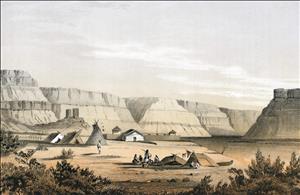On Saturday, November 27, 1847, the Roman Catholic Bishop of Walla Walla, Augustin Magliore Alexander Blanchet (1797-1887), and John Baptist Abraham Brouillet (1813-1884) leave Fort Walla Walla and establish St. Anne's Mission in a cabin on the Umatilla River. Blanchet, Brouillet, and others had arrived at Fort Walla Walla in September and had spent October making preparations to open this mission and another at the confluence of the Yakima and Columbia rivers. Two days after Blanchet and Brouillet open St. Anne's, Protestant missionaries Marcus (1802-1847) and Narcissa Whitman (1808-1847) and others will be killed at the Waiilatpu mission. St. Anne's Mission will be abandoned, burned, reestablished, burned again, abandoned again, and reestablished again before its mission will be resumed.
The Short-Lived Diocese of Walla Walla
In 1846, the Roman Catholic Church established the Diocese of Walla Walla, which extended between the Cascade and Rocky mountains and the California and Canadian borders. Augustin Magliore Alexander Blanchet became its bishop. Blanchet arrived at Fort Walla Walla, one of the few substantial structures in the diocese, on September 5, 1847. Blanchet began working to identify potential sites for mission stations and met with Hudson’s Bay Company officials, local tribal leaders, and Marcus Whitman, who had established a Protestant mission, Waiilatpu, up the Walla Walla River in 1836. The first Catholic mission within the diocese, St. Rose’s, was soon established by Pascal Ricard, Superior of the Oblates of Mary Immaculate, at the confluence of the Columbia and Yakima rivers. St. Anne’s was the next mission, which Blanchet established with John Baptist Abraham Brouillet on the Umatilla River, about 25 miles south of Waiilatpu.
On the morning of November 27, Blanchet, Brouillet, and Blanchet’s clerk left Fort Walla Walla and, around 3:30 in the afternoon, arrived at the cabin that Cayuse Chief Tawatoe (Young Chief) had offered to the mission that would be named for St. Anne. Whitman briefly visited the Catholic mission the next day, Sunday, but continued on to his own. On Monday, November 29, Whitman’s colleague Henry Spalding (1803-1874), stopped at St. Anne’s. That same day at Waiilatpu, Whitman, his wife Narcissa (1808-1847), and a number of others were killed by a band of Cayuse Indians who blamed Whitman for a measles epidemic that was ravaging their tribe. On the November 30, Brouillet traveled to a Cayuse camp near Waiilatpu and learned about the massacre. The next day he visited the mission and buried the dead. He then returned to his own mission to warn Spalding. The so-called Cayuse War followed, and in 1848 it became necessary to abandon St. Anne’s. Blanchet tried to return in June 1849, at the request of the Cayuse there, but he was not permitted to travel beyond The Dalles. He waited there for peace, but in 1850 Blanchet was transferred to the new Diocese of Nisqually and in 1853 the Diocese of Walla Walla was suppressed.
The Long-Lived St. Anne’s Mission
In 1852, Blanchet’s elder brother, regional Archbishop Francis Norbert Blanchet (1795-1883), asked Eugene Casimir Chirouse (1821-1892), one of the first priests ordained in the Northwest, to reestablish St. Anne’s. Chirouse did so and used it as a base for missionary work to the Cayuse near the Umatilla and those near the Walla Walla River, where he established St. Rose of the Cayuse Mission. This mission also served the local Frenchtown settlement near the Walla Walla River and was later renamed St. Rose of Lima. In 1855, during another battle, St. Anne’s was sacked and burned a second time. From early 1856 until 1859, when St. Patrick’s Church was established in the soon-to-be named town of Walla Walla, the regional records of the Catholic Church are silent.
In 1865, Adolph Vermeersch selected a new site for St. Anne’s on the south bank of the Umatilla River, where a church, residence, and school were built. In the 1880s, St. Anne’s was moved a couple more times and renamed St. Joseph’s. The mission was renamed again in 1893, to St. Andrew’s, and moved one more time in 1905 to its current location on the Umatilla Indian Reservation at 8022 St. Andrews Road, Pendleton, Oregon.

